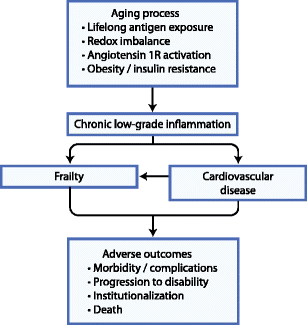Frailty in Patients with Cardiovascular Disease: Why, When, and How to Measure
- PMID: 21949560
- PMCID: PMC3165117
- DOI: 10.1007/s12170-011-0186-0
Frailty in Patients with Cardiovascular Disease: Why, When, and How to Measure
Abstract
Frailty is a geriatric syndrome of impaired resistance to stressors due to a decline in physiologic reserve. Frailty and cardiovascular disease (CVD) share a common biological pathway, and CVD may accelerate the development of frailty. Frailty is identified in 25% to 50% of patients with CVD, depending on the frailty scale used and the population studied. Frail patients with CVD, especially those undergoing invasive procedures or suffering from coronary artery disease and heart failure, are more likely to suffer adverse outcomes as compared to their non-frail counterparts. Five-meter gait speed is a simple and effective way of objectively measuring frailty in patients with CVD and should be incorporated in risk assessment.
Figures
References
-
- 2010 Statistical Fact Sheet: Older Americans and Cardiovascular Diseases. American Heart Association. (Accessed April 6 2011, at http://www.americanheart.org/downloadable/heart/1260811877868FS08OLD10.pdf).
LinkOut - more resources
Full Text Sources
Other Literature Sources


